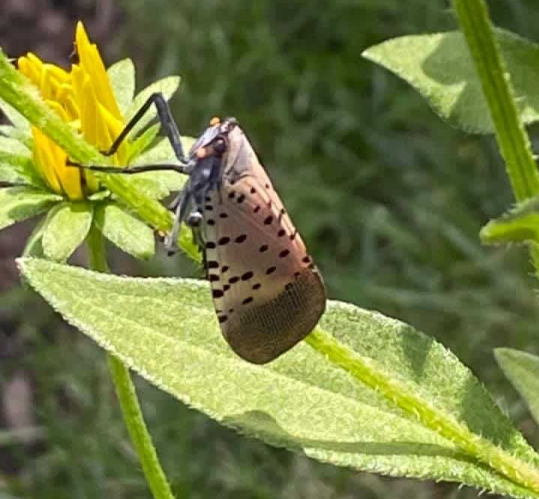CHARLOTTESVILLE, VA (CVILLE RIGHT NOW) – In recent years, Albemarle County has witnessed the spread of an invasive insect that threatens both local ecosystems and industries: the Spotted Lanternfly.
Their impact may be far greater than originally thought, so experts say “if you see them, squash them.”
Native to Asia, this destructive pest first appeared in the U.S. in Pennsylvania in 2014, and its rapid expansion across Virginia is cause for alarm. With the ability to damage over 70 species of trees, including vital agricultural crops, the Spotted Lanternfly poses a significant challenge for both homeowners and farmers in the region.
The Spotted Lanternfly is a planthopper, a type of insect that feeds on the sap of various plants. While it targets over 70 different species of trees, it has a particular affinity for the Tree of Heaven, an invasive species itself.
“The Lanternfly’s feeding behavior weakens trees, leaving them susceptible to diseases and other pests,” Virginis Department of Agriculture and Consumer Services’ Spotted Lanternfly Feild Supervisor Jules Amanita told Cville Right Now. “This feeding also has a direct impact on the agricultural industry, particularly in areas with vineyards, orchards, and hop yards, where crop damage can result in significant economic losses.”
In Charlottesville, agriculture plays a significant role in the local economy. Vineyards, orchards, and hops yards are vital to the region’s wine and craft beer industries, both of which have seen substantial growth in recent years.
“In Virginia, we are absolutely seeing reduced crops, the need for a lot more pesticides or other pest control measures,” said Amanita. “That poses significant additional burden on our growers.”
The Spotted Lanternfly poses a direct threat to these crops. By feeding on grapevines, apple trees, peaches, and other fruit-bearing plants, the Lanternflies weaken the plants, resulting in reduced crop yields and poor fruit quality.
For farmers, this means potential financial hardship, as the quality and quantity of their crops would decrease.
Additionally, these insects can become a nuisance for homeowners. When in large numbers, Spotted Lanternflies congregate on trees, fences, and outdoor furniture.
“The Spotted lanternfly is a sap feeder and it’s a very inefficient feeder,” said Amanita. “That sugar-laden sap ends up coating leaves and the forest floor, causing black sooty mold that blocks photosynthesis. This mold can further damage plants, making it an even bigger issue for local gardeners and landscapers.”
The Spotted Lanternfly’s feeding behavior can intensify problems related to other invasive species, especially the Tree of Heaven. This invasive tree is a primary food source for the pest and, in turn, contributes to the spread of them.
The Tree of Heaven outcompetes native species and its widespread presence only strengthens the Lanternfly population. As the Lanternfly feeds on both the Tree of Heaven and native trees, it further destabilizes the local ecosystem.
In 2021, the Lanternfly was confirmed in Albemarle County and since then, the pest has spread throughout various parts of the county.
“Last year was the first year that we were really seeing large numbers of spotted lanternfly in downtown Charlottesville,” said Amanita. “Now they’ve been confirmed in 68 counties and independent cities across Virginia.”
The impact of the Spotted Lanternfly goes beyond the aesthetic harm. “It’s an ecological and agricultural threat,” said Amanita. “We must continue to take preventative action.”
Experts stress the importance of keeping the spread contained.
“The quarantine was repealed, but checking vehicles and outdoor equipment is still critical,” said Amanita. “Many new infestations come from people unknowingly transporting them home from work or vacation. The main goal right now is to prevent spotted lanternfly from getting to the port cities, especially Hampton Roads which ship goods worldwide.”
In response to the Spotted Lanternfly threat, the community is being urged to take proactive measures to halt its spread. Here are some ways residents and businesses can help according to the Albermarle County website:
Inspect Vehicles and Outdoor Items: Before leaving a known infested area, individuals should carefully inspect their vehicles, trailers, boats, and ATVs for any signs of Lanternflies. This includes checking for egg masses, nymphs and adult insects.
Squash the Insect: If you spot a Spotted Lanternfly, take immediate action by squashing it. This simple step can significantly help reduce its spread, as it prevents the insect from laying eggs or migrating to new locations.
Remove the Tree of Heaven: Since the Tree of Heaven is the Spotted Lanternfly’s favorite food source, removing these invasive trees from your property can greatly limit the pest’s population. This method has been shown to reduce the egg masses by up to 75 percent, which can help slow its spread.
Report Sightings: If you spot a Spotted Lanternfly in an area that has not yet been affected, report it to local authorities or the Virginia Cooperative Extension. Timely reporting can help prevent further infestations.
While the presence of the Spotted Lanternfly in Charlottesville is concerning, the community has the power to take action and help prevent further damage.
“Every single spotted lanternfly that you kill helps,” said Amanita. “It truly does make a difference.”
For more detailed resources and guidelines on how to manage the Spotted Lanternfly, visit the Virginia Cooperative Extension’s website, and help ensure a healthier future for the region.



